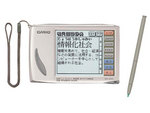Pocket PC as Japanese dictionary
I have heard that a Japanese Pocket PC model is the best thing to use as an electronic Japanese dictionary. Many companies make Pocket PCs. They come with the Microsoft Windows CE operating system — the Japanese version of this apparently has built-in Japanese handwriting recognition.





